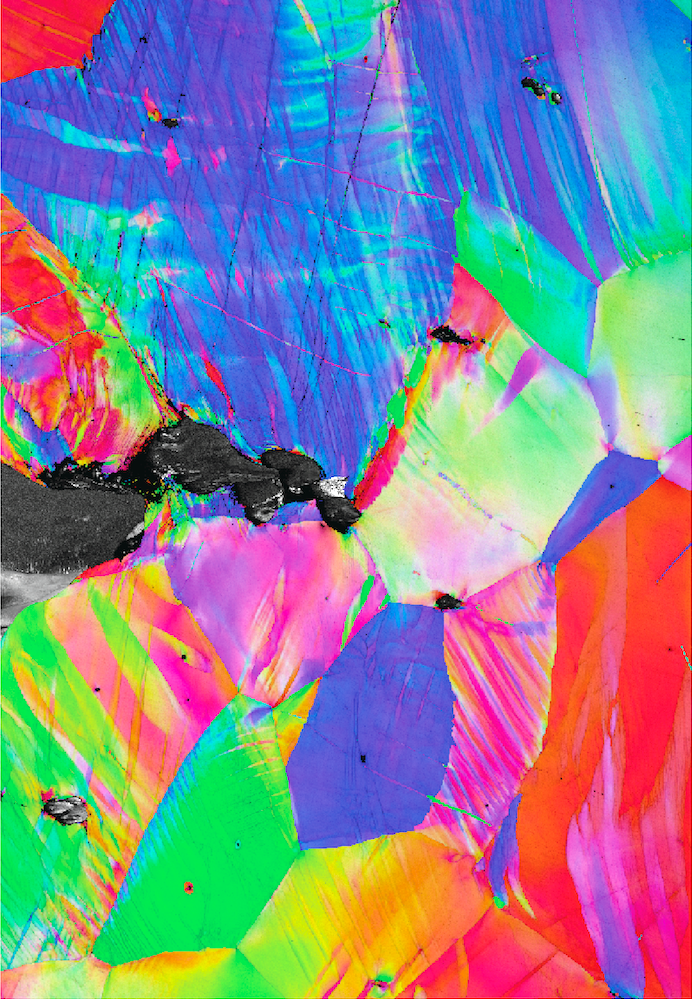Material made of niobium, tantalum, titanium, and hafnium exhibits astounding properties.
A team of U.S. researchers has developed a metal alloy made of niobium, tantalum, titanium, and hafnium that outshines other materials with its unusual properties. Nb45Ta25Ti15Hf15, as it is called, looks spectacular under the microscope and can withstand both extreme heat and cold without permanently deforming, cracking, or breaking – a combination that, according to the scientists, previously seemed almost impossible to achieve. This enormous resilience could be a first step in developing next-generation, highly efficient aerospace engines, as the highest possible operating temperatures are required in this field of application. The hotter the temperature at which fuel is burned, the more efficiently the heat is converted into electricity or thrust, explains lead author David Cook from the Lawrence Berkeley National Laboratory in California. One limitation, however, is the materials that can withstand this. Because current materials can no longer be further optimized for high temperatures, there is a great need for new metallic materials, says Cook.
The four metals are already common components of superalloys, which are suitable for high temperatures and intense mechanical stresses. The material developed by the U.S. researchers belongs to a new class, the so-called high or medium entropy refractory alloys (RHEAs/RMEAs). Unlike many conventional alloys, which consist of a main metal with small amounts of other elements, they are produced by mixing almost equal amounts of metallic elements at very high melting temperatures. This gives them unique properties that are currently the subject of intensive research and have not yet been fully unraveled.
20 Times Stronger Than Cryogenic Steel
The team led by study leader Robert Ritchie from Berkeley Lab also experienced a surprise during their studies. From previous work with RHEAs and RMEAs, the researchers knew that these materials are very strong but are among the most brittle metals. They were downright shocked when Nb45Ta25Ti15Hf15, on the other hand, exhibited exceptional toughness, says author Punit Kumar. The new alloy is over 25 times tougher than typical RMEAs at room temperature and even 20 times tougher than so-called cryogenic steels, which are hardened by extreme cold and specially developed for fracture resistance.

The view under the scanning electron microscope shows the alloy at -196 degrees Celsius with so-called kink bands that have formed near a crack tip. Kink bands are a type of defect in the material structure and, in this case, are responsible for the unusual toughness of the alloy.
Photo: Berkeley Lab
The scientists evaluated the strength and toughness of the material at five temperatures: -196 degrees Celsius—the temperature of liquid nitrogen—25 degrees Celsius, i.e., room temperature, 800, 950, and 1,200 degrees Celsius—the latter corresponds to around a fifth of the surface temperature of the sun. Although the alloy showed the highest strength at low temperatures, the values were still “impressive” at higher temperatures. The crack resistance was high at all temperatures.
Investigations using electron microscopes finally shed light on the origin of the unusual properties of Nb45Ta25Ti15Hf15. According to the Berkeley Lab press release, a defect in the material’s structure, which was previously assumed to promote fractures, actually has the opposite effect and is responsible for the high toughness.
However, according to Ritchie, a great deal of basic research and technical testing is still required before the alloy can be used in airplane or rocket propulsion units. However, the study shows that the metal has potential for future engines.
More innovation: Hafnium could also play a decisive role in another future technology as a component of another newly developed alloy that could pave the way to the “holy grail of energy production,” nuclear fusion.
Featured image: Berkeley Lab


